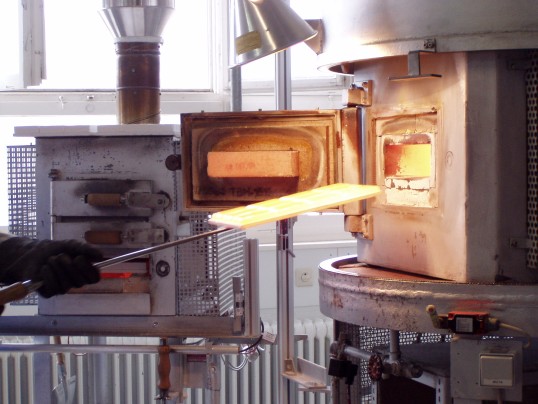- Artificial Intelligence (AI)
- Occupational exposure limit values
- Climate Change and Occupational Safety
- List of CMR substances
- Electromagnetic fields
- Ergonomics
- Industrial Security
- Collaborative robots
- Noise
- Nanoparticles at the workplace
- Optical Radiation
- REACH
- Reference materials
- Proficiency testing
- Vibration
- Virtual reality
- Work 4.0
Artificial incoherent optical radiation
Optical radiation from artificial sources comprises three essential wavelength ranges, analogous to the components of the solar radiation spectrum: ultraviolet (UV) radiation (100 to 400 nm), visible light (400 to 800 nm) and infrared (IR) radiation (800 nm to 1 mm). The shorter the wavelength, the higher the energy of the photons and thus the greater the potential risk of harm being caused by the radiation.
Workers are frequently exposed to optical radiation during their occupational tasks. Outdoor workers are exposed to a natural source of radiation - the sun. However, optical radiation may also occur during indoor work processes. Firstly, it is used intentionally in some processes, for example during glass bonding, UV printing or microcrack testing. Secondly, it can arise as an undesired incidental phenomenon, for example during welding, work involving gas torches, or metal or glass fusion.
In order for scientifically validated conclusions to be drawn regarding possible hazards presented by incoherent optical radiation, the exposure must be determined by means of suitable measurement methods. On behalf of the German Social Accident Insurance Institutions, the IFA conducts measurements and consulting concerning workplace exposure to radiation. The spectrum of measurements performed for this purpose ranges from simple survey measurements for approximate estimation of the sources presenting a hazard, to detailed study of specific work situations. Such measurements generally last one to two days, depending upon the number of workplaces or sources of radiation examined, and in most cases involve the methods described in EN 14255, Measurement and assessment of personal exposures to incoherent optical radiation.
Where individual sources of radiation are transportable, they can also be studied precisely in the laboratory. They are then characterized with reference to EN 62471, Photobiological safety of lamps and lamp systems.
When taking measurements at the workplace, it is important to first record the entire radiation spectrum in order to determine the wavelength ranges that need to be considered in the risk assessment. Instruments optimized for each wavelength range (UV, visible, IR) are then used to determine the hazard more precisely. A wide range of exposure situations arise in industrial environments; prediction or estimation of the radiation based on a description provided is therefore often very imprecise.
A report (in German only) has been published containing an overview of exposure situations frequently encountered in practice. Owing to the high radiation levels, the associated hazards and the substantial number of affected workplaces, the IFA has conducted research specifically into UV radiation emission during arc welding (IFA Informative document, in German only). The radiation spectra of a number of welding methods (XLS, 114 kB) determined by this research are available for download.
Gas torches (PDF, 299 kB, non-accessible) were also studied owing to their radiation emissions, which however had not previously been quantified. An IFA Report on these studies has been published (in German only).
The measurement results form the basis for risk assessment and can be used to determine measures for protection against incoherent optical radiation. The applicable exposure limits are also used to assess the risk.
Despite intensive efforts to protect workers against excessive exposure to incoherent optical radiation, individual cases of an occupational disease may nevertheless arise.
In our projects, we address issues that have arisen in the field, and in turn apply the results of the projects in day-to-day activity in industry.

Reports (in German only)
UV-Strahlenexposition an Arbeitsplätzen (BGIA-Report 3/2007) (PDF, 869 KB)
"UV radiation exposure at workplaces"
Emissionen optischer Strahlung bei der Bearbeitung von Werkstücken aus Glas mit Gasbrennern (IFA Report 6/2016) (PDF, 3,1 MB)
"Emissions of optical radiation during the working of glass workpieces by means of gas torches"
IFA Informative Publications (in German only)
Emission von UV-Strahlung beim Elektroschweißen (PDF, 128 KB)
"Emission of UV radiation during arc welding"
UV-Strahlenexpositionenbei der Glasbearbeitung mit Gasbrennern (PDF, 299 kB, non-accessible)
"UV radiation exposure during glasswork involving gas torches"
Further information


